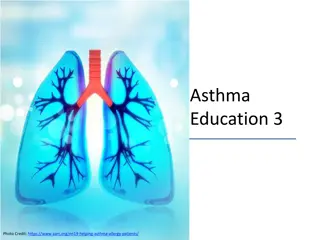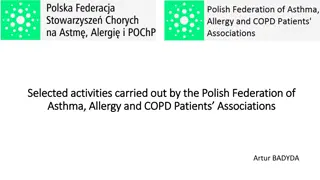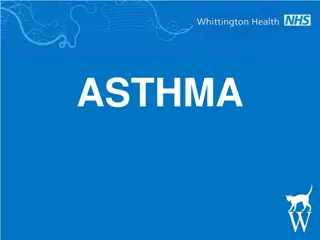
Effective Management Strategies for Asthma and Stepwise Treatment Approach
Asthma is a common respiratory disease affecting millions worldwide. Long-term treatment options aim to prevent exacerbation of symptoms, while quick relief medications provide immediate symptom relief. Both medication types have specific effects on patients. Utilizing a stepwise treatment and management approach is crucial in determining the appropriate therapy for asthma control.
Download Presentation

Please find below an Image/Link to download the presentation.
The content on the website is provided AS IS for your information and personal use only. It may not be sold, licensed, or shared on other websites without obtaining consent from the author. If you encounter any issues during the download, it is possible that the publisher has removed the file from their server.
You are allowed to download the files provided on this website for personal or commercial use, subject to the condition that they are used lawfully. All files are the property of their respective owners.
The content on the website is provided AS IS for your information and personal use only. It may not be sold, licensed, or shared on other websites without obtaining consent from the author.
E N D
Presentation Transcript
ASTHMA AND STEPWISE MANAGEMENT STUDENTS NAME: INSTITUTION AFFILIATION: DATE:
ASTHMA Asthma is a respiratory disease that causes the inflammation of the airways and the lungs It affects over 400 million people globally (Khalid, 2015). Major symptoms associated with the disease include shortness of breath, coughing and wheezing Common asthma triggers are allergens like dust mites, drugs like aspirin, viral infections, exercise, tobacco and other nicotine enhanced products Various approaches are used to control the disease including long-term control and quick relief treatment options (Choby & Lee, 2015).
LONG TERM TREATMENT OPTIONS Main purpose for the long-term treatment option is to prevent exacerbation of symptoms as well as control asthma This option is most effective in prevention of asthma attacks and chronic symptom control Specific medications used for long-term treatment include long-acting beta-agonists, inhaled corticosteroids, theophylline and leukotriene modifiers (Sobieraj et al, 2018). All these medications are effective but inhaled corticosteroid is more effective in long-term control.
QUICK RELEIF TREATMENT OPTIONS Quick relief medications also called fast acting or rescue medications are used to relieve symptoms of asthma They work fast to control major asthmatic symptoms which include shortness of breath, wheezing and coughing Specific medications used for quick relief treatment include Albuterol ,Pirbuterol, Terbutaline, Metaproterenol and Bitolterol ( Magee, Pittman& Jette-Kelly, 2018). These medications work by relaxing the airway muscles thus eliminating the symptoms faster. That is why they are known as bronchodilators
DRUG IMPACT ON PATIENT Both long term and quick relief medications play a critical role to control and manage asthma However there are specific effects associated with them They include hoarseness, thrush and coughing for the long term treatment options. In children they also cause delayed or suppressed growth. headaches, restlessness, anxiety, tremors, uneven and fast heartbeats re common effects associated with quick relief medications.
STEPWISE TREATMENT AND MANAGEMENT APPROACH Stepwise approach is critical in deciding the step of therapy to use that coincide with the severity level of asthma There are six primary steps involved in the stepwise approach. Step one that entails use of short acting beta-agonist to address intermittent asthma Step two , three, four ,five and six that involves treatment of persistent asthma by taking daily medication. The main differences between these five steps is the recommended dosage. Low-dose inhaled corticosteroids(ICS) for step 2, medium-dose ICS for step 3, LABA and medium-dose ICS for step 4, LABA and high-dose ICS for step 5 and oral corticosteroid , LABA plus and high-dose ICS for step 6 (Holt 2016).
GAINING AND MAINTAINING CONTROL OF ASTHMA Stepwise approach is an instrumental tool in helping both the healthcare providers and the patients gain and maintain control of asthma. Healthcare providers are able to determine the severity level of asthma as well as the treatment options to use to attain asthma control. Stepwise approach also involves patient education which is critical in helping the patient identify triggers, symptoms and also how to manage their condition individually The approach is significant in guiding the providers and the patient the effective action plans to control and manage asthma.
REFFERENCES Choby, G. W., & Lee, S. (2015, September). Pharmacotherapy for the treatment of asthma: current treatment options and future directions. In International forum of allergy & rhinology (Vol. 5, No. S1, pp. S35-S40). Holt TO. (2016). Stepwise approach to asthma management. RT: The Journal for Respiratory Care Practitioners, 22(5), 12 17. Khalid, A. N. (2015). Stepwise management of asthma. International Forum of Allergy & Rhinology, 5 Suppl 1, S41 S44. https://doi-org.lopes.idm.oclc.org/10.1002/alr.21606 Magee, J. S., Pittman, L. M., & Jette-Kelly, L. A. (2018). Paradoxical Bronchoconstriction with Short-Acting Beta Agonist. The American Journal of Case Reports, 19, 1204 1207. https://doi-org.lopes.idm.oclc.org/10.12659/AJCR.910888 Sobieraj, D. M., Weeda, E. R., Nguyen, E., Coleman, C. I., White, C. M., Lazarus, S. C., ... & Baker, W. L. (2018). Association of inhaled corticosteroids and long-acting -agonists as controller and quick relief therapy with exacerbations and symptom control in persistent asthma: a systematic review and meta-analysis. Jama, 319(14), 1485-1496.






















